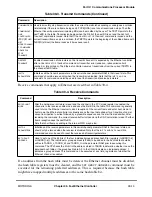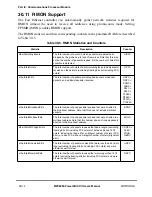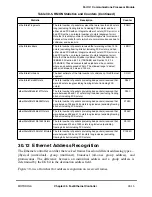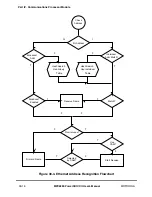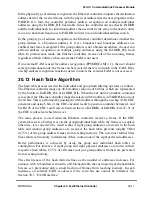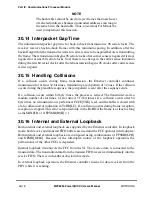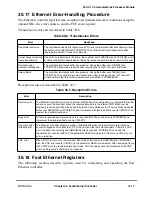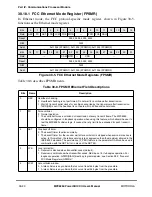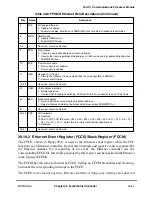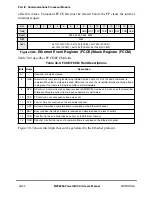
MOTOROLA
Chapter 30. Fast Ethernet Controller
30-13
Part IV. Communications Processor Module
Receive commands that apply to Ethernet are described in Table 30-4.
If an address from the hash table must be deleted, the Ethernet channel must be disabled,
the hash table registers must be cleared, and the
SET
GROUP
ADDRESS
command must be
executed for the remaining preferred addresses. This is required because the hash table
might have mapped multiple addresses to the same hash table bit.
C
OMMANDS
:
FA
ST
COMMUNICATI
ONS
CONTROLLER
(FCC):E
THER
NET
MODE
:
TRANSMI
T
COMMANDS
GRACEFUL
STOP
TRANSMIT
Used to smoothly stop transmission after the current frame Þnishes sending or undergoes a collision
(immediately if there is no frame being sent). FCCE[GRA] is set once transmission stops. Then the
Ethernet transmit parameters (including BDs) can be modiÞed by the user. The TBPTR points to the
next TxBD in the table. Transmission begins when the R bit of the next BD is set and the
RESTART
TRANSMIT
command is issued. Note that if the
GRACEFUL
STOP
TRANSMIT
command is issued and the
current transmit frame ends in a collision, the TBPTR points to the beginning of the collided frame with
TxBD[R] still set (the frame looks as if it was never sent).
RESTART
TRANSMIT
Enables transmission of characters on the transmit channel. It is expected by the Ethernet controller
after a
GRACEFUL
STOP
TRANSMIT
command or transmitter error (underrun, retransmission limit
reached, or late collision). The Ethernet controller resumes transmission from the current TBPTR in
the channel TxBD table.
INIT
TX
PARAMETERS
Initializes all the transmit parameters in this serial channel parameter RAM to their reset state. This
command should be issued only when the transmitter is disabled. Note that the
INIT
TX
AND
RX
PARAMETERS
command can also be used to reset the transmit and receive parameters.
Table 30-4. Receive Commands
Command
Description
ENTER
HUNT
MODE
After the hardware or software is reset and the channel in the FCC mode register is enabled, the
channel is in the receive enable mode and uses the Þrst BD in the table. This command is generally
used to force the Ethernet receiver to abort reception of the current frame and enter hunt mode. In
hunt mode, the Ethernet controller continually scans the input data stream for a transition of carrier
sense from inactive to active followed by a preamble sequence and the start frame delimiter. After
receiving the command, the current receive buffer is closed and the CRC calculation is reset. Further
frame reception uses the next RxBD.
Note that short frames pending in the internal FIFO may be lost.
INIT
RX
PARAMETERS
Initializes all the receive parameters in this serial channel parameter RAM to their reset state and
should only be issued when the receiver is disabled. Note that the
INIT
TX
AND
RX
PARAMETERS
command can also be used to reset the receive and transmit parameters.
SET
GROUP
ADDRESS
Used to set one of the 64 bits of the four individual/group address hash Þlter registers (GADDR[1Ð4]
or IADDR[1Ð4]). The individual or group address (48 bits) to be added to the hash table should be
written to TADDR_L, TADDR_M, and TADDR_H in the parameter RAM prior to executing this
command. The CP checks the I/G bit in the address stored in TADDR to determine whether to use the
individual hash table or the group hash table. A 0 in the I/G bit indicates an individual address; 1
indicates a group address. This command can be executed at any time, regardless of whether the
Ethernet channel is enabled.
Table 30-3. Transmit Commands (Continued)
Command
Description
Summary of Contents for MPC8260 PowerQUICC II
Page 1: ...MPC8260UM D 4 1999 Rev 0 MPC8260 PowerQUICC II UserÕs Manual ª ª ...
Page 66: ...lxvi MPC8260 PowerQUICC II UserÕs Manual MOTOROLA ...
Page 88: ...1 18 MPC8260 PowerQUICC II UserÕs Manual MOTOROLA Part I Overview ...
Page 120: ...2 32 MPC8260 PowerQUICC II UserÕs Manual MOTOROLA Part I Overview ...
Page 138: ...Part II iv MPC8260 PowerQUICC II UserÕs Manual MOTOROLA Part II Configuration and Reset ...
Page 184: ...4 46 MPC8260 PowerQUICC II UserÕs Manual MOTOROLA Part II ConÞguration and Reset ...
Page 202: ...Part III vi MPC8260 PowerQUICC II UserÕs Manual MOTOROLA Part III The Hardware Interface ...
Page 266: ...8 34 MPC8260 PowerQUICC II UserÕs Manual MOTOROLA Part III The Hardware Interface ...
Page 382: ...10 106 MPC8260 PowerQUICC II UserÕs Manual MOTOROLA Part III The Hardware Interface ...
Page 392: ...11 10 MPC8260 PowerQUICC II UserÕs Manual MOTOROLA Part III The Hardware Interface ...
Page 430: ...Part IV viii MOTOROLA Part IV Communications Processor Module ...
Page 490: ...14 36 MPC8260 PowerQUICC II UserÕs Manual MOTOROLA Part IV Communications Processor Module ...
Page 524: ...17 10 MPC8260 PowerQUICC II UserÕs Manual MOTOROLA Part IV Communications Processor Module ...
Page 556: ...18 32 MPC8260 PowerQUICC II UserÕs Manual MOTOROLA Part IV Communications Processor Module ...
Page 584: ...19 28 MPC8260 PowerQUICC II UserÕs Manual MOTOROLA Part IV Communications Processor Module ...
Page 632: ...21 24 MPC8260 PowerQUICC II UserÕs Manual MOTOROLA Part IV Communications Processor Module ...
Page 652: ...22 20 MPC8260 PowerQUICC II UserÕs Manual MOTOROLA Part IV Communications Processor Module ...
Page 668: ...23 16 MPC8260 PowerQUICC II UserÕs Manual MOTOROLA Part IV Communications Processor Module ...
Page 758: ...27 28 MPC8260 PowerQUICC II UserÕs Manual MOTOROLA Part IV Communications Processor Module ...
Page 780: ...28 22 MPC8260 PowerQUICC II UserÕs Manual MOTOROLA Part IV Communications Processor Module ...
Page 874: ...29 94 MPC8260 PowerQUICC II UserÕs Manual MOTOROLA Part IV Communications Processor Module ...
Page 920: ...31 18 MPC8260 PowerQUICC II UserÕs Manual MOTOROLA Part IV Communications Processor Module ...
Page 980: ...A 4 MPC8260 PowerQUICC II UserÕs Manual MOTOROLA Appendixes ...
Page 1002: ...Index 22 MPC8260 PowerQUICC II UserÕs Manual MOTOROLA INDEX ...
Page 1006: ......















